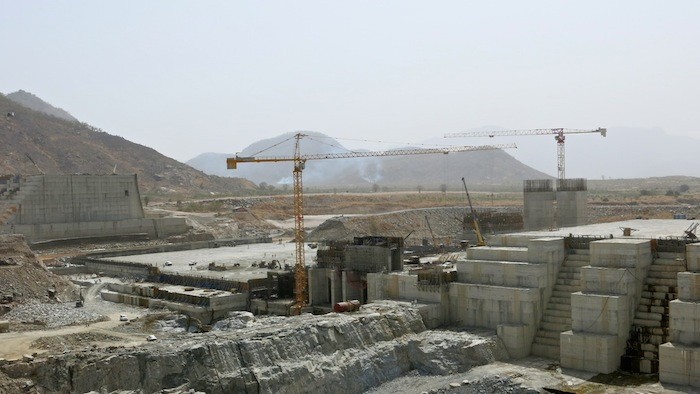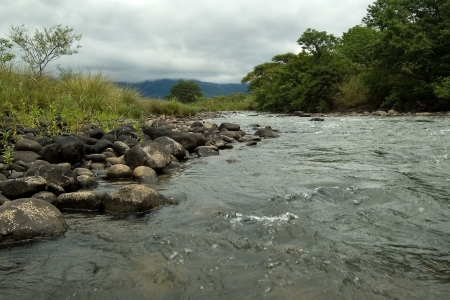While Ethiopia hosts a global discussion on aid finance this week, a long-running dispute with its neighbours over how to share the Nile could be reaching a peaceful conclusion.
Egypt, famously, is “the gift of the Nile”. The world’s longest river has over the millennia sustained one of the oldest civilizations on Earth. Without its waters, the country would be nothing but desert. So no wonder there was concern in 2011, when way upstream on its largest tributary, the Blue Nile in the Ethiopian highlands, thousands of workers began building a dam that could hold back the river’s entire flow for more than a year.

Everybody remembered the warning of Boutros Boutros-Ghali, Egypt’s foreign minister who warned that his country would go to war to stop such a dam. And yet, with the dam now almost half-completed, and scheduled to begin holding back the Nile in two years, the talk is now of water peace rather than water war.
In late March, ministers from Egypt, Ethiopia and Sudan, the three main countries along the Blue Nile, struck a preliminary deal aimed at resolving technical arguments and reaching a final agreement on sharing the river’s waters that would respect their respective needs. Ethiopia has had the right to develop its economy by building the Grand Ethiopian Renaissance Dam (GERD) for hydroelectric power, while Egypt and Sudan had the right to insist that they did not suffer “significant harm”.
The aim now is to agree on a final deal by this time next year.
The question is, can it be done? Who will give ground? Or can there be collective gains that outweigh individual losses?
Changing flows
The hope is that a deal that brings cooperation to management of the Nile’s waters could deliver benefits for all. That was the key message from an international group of experts who met last November at MIT in the US to provide confidential advice for the negotiators – advice that has now been made public and should form the basis of the final deal.
The good news for those living downstream is that the Ethiopian dam is being built purely for generating electricity. The water it traps will eventually flow downstream. The uncertainty is about the timing of those releases, during droughts and especially while the reservoir behind the dam fills for the first time. That could take several years.
Egypt is especially vulnerable to any reduction in flow down the Blue Nile because for some years it has been taking more water from the Nile than even is allowed under the 1959 Nile Water Agreement. The agreement, a product of colonial times, gives 75 per cent of flow to Egypt, 25 per cent to Sudan – and none to anyone else. Naturally, most nations on the Nile reject it.
Egypt has been able to exceed even this quota, taking roughly 90 per cent of the Nile’s flow, because Sudan lacks a megadam that could trap its share of the Blue Nile’s flow during its short summer monsoon season. So the excess has flowed on into Egypt. But the completion of the GERD will change the short summer flood into a steady year-long flow, dictated by electricity demand. Possible consequences of this and other flow release characteristics might be high priority for the international group of experts to report on.
Sudanese farmers who currently plant their crops on the river’s wet floodplain will lose out as the waters recede. There will be no flood. But Sudan already has plans for big irrigation projects that will divert increasing shares of the more predictable and controllable flows. It could soon be extracting its full water entitlement under the 1959 agreement, according to analysts spoken to for this piece.
So while Ethiopia may not take water from the river as a result of the dam, Sudan almost certainly will. The effect on Egypt’s farmers will be the same: less water.
Egypt has come to rely on these extra flows to get rid of another problem – the accumulation of toxic levels of salt in its fields on the Nile delta. Each year, large amounts of water are poured onto fields to flush out the salts before planting begins. The experts conclude that Ethiopia’s dam will cut the water available for flushing. This, they say, “could create a political crisis in the basin if Egyptian farmers and policymakers blame their problem on Ethiopia and the GERD.”
The silver lining
But there is a silver lining. The surprising suggestion from the study is that, whatever the perceived risks downstream, the GERD could create gains for all sides, if its management was coordinated with that of Egypt’s High Aswan dam downstream. The key gain from running the two dams in harness would be to reduce evaporation from reservoirs along the river.
The reservoir behind the High Aswan dam, Lake Nasser, spreads across the Nubian desert for more than 5000 square kilometres. In the tropical sun, it loses an estimated 16 cubic kilometres of water to evaporation in a typical year. This is around a quarter of the entire volume entering it, and up to 40 per cent in dry years.
If more water could be stored instead in the reservoir behind the GERD, in the colder and cloudier Ethiopian highlands, then total evaporation losses from reservoirs on the river could be dramatically cut, the experts conclude. The main requirement for achieving this is not hydrological but political. The downstream countries need to have confidence that they would get their water as needed.
There are difficulties. Less water in the High Aswan dam would reduce its potential to generate hydroelectricity for Egypt. But there is a quid pro quo here. The GERD will double Ethiopia’s electricity generating capacity. For a long time to come, the country will have spare power and it plans to distribute that down transmission lines to neighbours, including Sudan and Egypt. Again, say the experts, there is the potential for a deal to benefits all sides, based on exchanging water for power.
Despite many years of debate about sharing the river’s waters, there remains a huge amount that is unknown about natural flows and the impacts of the proposed changes. An important purpose of the studies now being planned is to create confidence about what is possible by removing uncertainty. But it is equally clear that any future agreement will only work if there is continuing input of independent research to monitor how the dams are managed and advise on reducing tensions.
It might be a bit early to talk about peace breaking out on the Nile. But the new dam will create new options for the three countries to share its beneficence. Maybe, in the future, Egypt will not be alone as “the gift of the Nile.”















